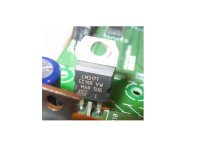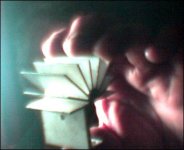I have just killed my second wall-wart. No smell, no dimming of house lights; didn't find any hot parts.
What I was doing is, I made a 48volt phantom power supply and a +/-15volt supply, going to a diy mic preamp ( one at a time, but two different ones; both use opamps). The chain starts with a 24volt ac wall-wart - the diy power supplies work Ok, it happened when I was giving the preamps their maiden voyages.
The warts still put out 1-3 volts; not entirely dead. What kinds of things should I look for, that could be wrong?
One thing I'm not sure of - do I combine the P48 ground, the +0-15V ground, and the audio cable shield to go to chassis, then tie a star ground on the preamp including the opamp refs, then tie that to chassis?.
What I was doing is, I made a 48volt phantom power supply and a +/-15volt supply, going to a diy mic preamp ( one at a time, but two different ones; both use opamps). The chain starts with a 24volt ac wall-wart - the diy power supplies work Ok, it happened when I was giving the preamps their maiden voyages.
The warts still put out 1-3 volts; not entirely dead. What kinds of things should I look for, that could be wrong?
One thing I'm not sure of - do I combine the P48 ground, the +0-15V ground, and the audio cable shield to go to chassis, then tie a star ground on the preamp including the opamp refs, then tie that to chassis?.
can you draw any current? you may be just seeing capacitve coupling if your'e looking with a hi Z probe
typically there is a fuse - embedded in the transformer winding so you may not see a separate component if you've hacked the case open
likely you're exceeding the power rating - can take a long time for the fuse to blow with a small continuous overload
or a turn-on charging surge may take a random # of starts before it goes
typically there is a fuse - embedded in the transformer winding so you may not see a separate component if you've hacked the case open
likely you're exceeding the power rating - can take a long time for the fuse to blow with a small continuous overload
or a turn-on charging surge may take a random # of starts before it goes
Large filter capacitors on a bridge rectifer are going to give your little transformer an ugly power factor to deal with and the wire used in the primary windings of these is so fine they are often considered "self limiting" and therefore have no (other) fuses or thermal protection. The largest ones do have special overload protection because the primary winding heavy enough to cause damage before it would significantly limit current or fuse. You might safely load a 24VAC transformer at less than half the rated transformer current to the DC output. If you're under that by design you either have a faulty circuit or defective transformers. If you're over that a bigger transformer is probably better.
Wall wart deaths..
Yes indeed wall-warts are an engineering disaster waiting to happen.
I will reiterate heat and overloads are the killer of WWs'.
When you design a device to the lowest common denominator you have a device that performs at the lowest level.
The designers wrap up these things in a glued up plastic case & depend on internal "overload protection" to save the device.
The caveat "Unplug when not in use" is roundly ignored and these devices gather dust being plugged into the wall 24/7.....365.
When you peer into ANY device & see THIS three pin device, without THIS or similar heatsink........figure the designer is a flake.
________________________________________________________Rick....
Yes indeed wall-warts are an engineering disaster waiting to happen.
I will reiterate heat and overloads are the killer of WWs'.
When you design a device to the lowest common denominator you have a device that performs at the lowest level.
The designers wrap up these things in a glued up plastic case & depend on internal "overload protection" to save the device.
The caveat "Unplug when not in use" is roundly ignored and these devices gather dust being plugged into the wall 24/7.....365.
When you peer into ANY device & see THIS three pin device, without THIS or similar heatsink........figure the designer is a flake.
________________________________________________________Rick....
Attachments
I have just killed my second wall-wart.
Pete, all power supplies need to be matched to their target circuits, and wall-warts are no different. Consider working out your circuit fully, including calculation of load, and then design the power supply to suite (wall-wart or otherwise).
Jersey Central Power and Light kills wall-warts as sport.
Lost the wall wart for my wireless router and Dymo label printer when JCP&L turned the power back on after our floods. Some of the engineering guys have repeatedly screwed up the process of restarting the sequence and it's been discussed in the local paper. A few months ago when the power was down owing to a snow storm the switch mode power supply on our Kitchen-Aid fridge was destroyed by a transient -- fried the circuit board, smps filter caps etc.
Lost the wall wart for my wireless router and Dymo label printer when JCP&L turned the power back on after our floods. Some of the engineering guys have repeatedly screwed up the process of restarting the sequence and it's been discussed in the local paper. A few months ago when the power was down owing to a snow storm the switch mode power supply on our Kitchen-Aid fridge was destroyed by a transient -- fried the circuit board, smps filter caps etc.
I have just killed my second wall-wart. No smell, no dimming of house lights; didn't find any hot parts.
What I was doing is, I made a 48volt phantom power supply and a +/-15volt supply, going to a diy mic preamp ( one at a time, but two different ones; both use opamps). The chain starts with a 24volt ac wall-wart - the diy power supplies work Ok, it happened when I was giving the preamps their maiden voyages.
The warts still put out 1-3 volts; not entirely dead. What kinds of things should I look for, that could be wrong?
One thing I'm not sure of - do I combine the P48 ground, the +0-15V ground, and the audio cable shield to go to chassis, then tie a star ground on the preamp including the opamp refs, then tie that to chassis?.
Many (all?) have fuses wound into the primary. Put a short on the secondary and blow the fuse. Legally you're not supposed to replace them but I've done it a few times. The ones that are screwed together are pretty easy. The 'welded' ones are a little more fun to take apart.
The phantom power ground should be the same as the signal ground so that the barrel of the mic is at the same potential as the signal ground. It COULD function properly with weird grounds but if the mic touched other gear it could blow out the inputs - not a nice experience when in the field trying to record the kid's piano recital and you took out the mic peamp - and maybe the mics.
The real question is how are you getting split 15 Volt supplies and a 48 volt phantom from one 24 V secondary? Even with voltage doublers it's a problem. Are you sure you actually require 48 Volts for the phantom power? My AKG C451s specify anything from 9-52 Volts. I've been running them on 24 since 1982
G²
Here’s what happened to me: I have a wall wart rated at 15vdc at 400ma. The circuit called for 12-18vdc, but I did not know how much current it needed. Everything was working good, this is a headphone amp, until I disconnected the wall wart. When I connected it again, and there was a spark at the input connection. I then measured the voltage for the wall wart with a multimeter and it was reading 22vdc, not 15vdc. I actually connected it again, which I should not have, and there was a very loud hum when I turned up the volume. So, I’m not sure if the wall wart went bad, and if the circuit was already damaged at that point. 
This is a cheap diy kit that did not come with a power supply, and only specified it needed 12-18vdc, but no mention about the current it needed. So, I’m assuming maybe the wall wart went bad because the circuit needed more than 400ma to work properly.
This is a cheap diy kit that did not come with a power supply, and only specified it needed 12-18vdc, but no mention about the current it needed. So, I’m assuming maybe the wall wart went bad because the circuit needed more than 400ma to work properly.
Last edited:
Wall warts here rated for 500 mA are usually good for 150 mA, but a small headphone amp, I would not know the current drain.
Better to use a proper SMPS, say from a scrapped laptop.
Or a really good linear supply you built yourself, or know is properly made to handle the load.
Better to use a proper SMPS, say from a scrapped laptop.
Or a really good linear supply you built yourself, or know is properly made to handle the load.
- Home
- Live Sound
- Instruments and Amps
- What Kills Wall-Warts?

